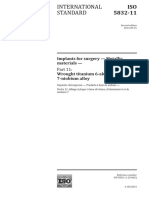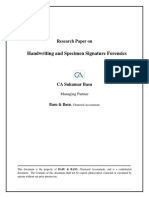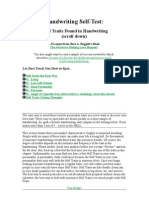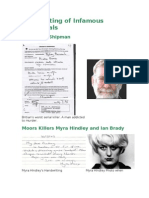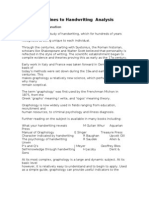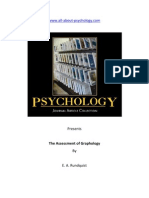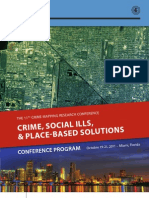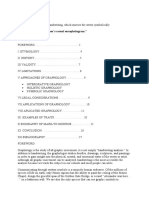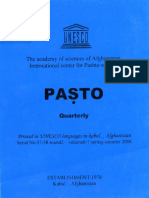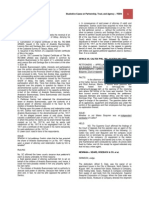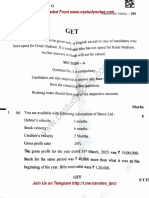Sheila Lowe Article PDF
Sheila Lowe Article PDF
Uploaded by
jansim12Copyright:
Available Formats
Sheila Lowe Article PDF
Sheila Lowe Article PDF
Uploaded by
jansim12Original Description:
Original Title
Copyright
Available Formats
Share this document
Did you find this document useful?
Is this content inappropriate?
Copyright:
Available Formats
Sheila Lowe Article PDF
Sheila Lowe Article PDF
Uploaded by
jansim12Copyright:
Available Formats
18 CITATIONS APRIL 2005
Forgery and the Handwriting Expert What Attorneys Need to Know
By Sheila R. Lowe
he professional forger is an extremely rare breed and is more likely to target major companies than individuals or small businesses. However, non-skilled attempts at forgery are increasing in frequency and are often made by the opportunist who sees his chance at some easy money. Maybe hes found a lost credit card or checkbook, and decides to try his luck. Or he thinks dear old dad should have left the family fortune to him, rather than his beautiful young stepmother, so he forges the signature on a grant deed to the family home, or a new will, taking everything for himself. In addition, the sharp rise in identity theft presents many opportunities for the forger.
sible to write a signature 100% the same way twice, the easiest way to prove a cut and paste forgery is to locate the document from which the name was traced. They will be identical, or extremely close if the forger is clever enough to change some minor details, such as the final strokes. Closely related to the cut-and-paste is the electronic forgery. In the computer age, the scan-and-drop method has evolved. The forger simply digitizes a genuine signature by scanning at a high resolution, then inserts it into the spurious document and prints it. Voila! He has what appears to be a genuine signature. Under the microscope, however, the pixelation reveals that it has been digitized. A fifth type of forgery is the freehand signature. The forger simply writes the victims name without making any attempt to copy. The Fraud and Forgery Division of the LAPD is said to have hundreds of examples where the forger has written some made-up phrase, disguised as a signature. One says, youve been had, sucker.
have identical handwritings. Dr. Sagur Srihari of the University of Buffalo, discovered this while working on software to identify handwriting for the U.S. Postal Service, and he has published research proving that each persons handwriting is unique (http://www.cedar.buffalo.edu/ news.html). A skillful forgery requires better than average hand-eye coordination and a great deal of practice. Artistic talent helps, too. Handwriting is a highly complex neuromuscular activity that requires coordination between the hand, arm, and fingers, as well as the eyes. Once graphic maturity has been reached in other words, once a child has learned how to write writing becomes a natural act, acquired over time. It is no longer necessary to stop and think about each stroke and how to get it right. Unless there is a physiological or psychological problem, genuine handwriting is usually smooth, spontaneous, and free-flowing, with less focus on the movement and more on the content. The forger, on the other hand, is forced to maintain constant control over the pen, concentrating intently on each minute detail. Under the microscope, the writing line will show frequent stops and hesitations, and the tighter grip the forger must maintain on the pen, in turn, produces heavier pressure on the paper. By the time he reaches the end of the signature, the forger has usually forgotten to stick to the victims style and his own natural style creeps in. Thus, the handwriting examiner pays the greatest attention to the ends of letters, words, and lines, rather than the beginnings. A signature thats simplified to a squiggly line can be problematic, as there is just not sufficient complexity on which to base an identification; thus, a signature written as a squiggle is the easiest to forge due to the lack of clear forms. The clearer a signature is, the harder it is to create a successful forgery. Something the forger usually forgets to change is the way numbers are written. In his effort to copy the victims signature, he attempts to mimic the pictorial aspects of capital letters, the writing size and the slant. Numbers and other writing (such as the name of the payee on a check), however, are usually ignored, and that can be a dead giveaway. Sheila Lowe is a court-qualified handwriting expert since 1984 and the author of two published books and a software package on handwriting analysis. www.sheilalowe.com
Types of Forgeries
When it comes to forgery, one size does not fit all. There are several different types, the most common of which is the simulation. In this case, the forger has access to a model of the genuine signature from which to practice making copies. He attempts to copy the pictorial characteristics the way the writing looks in order to make it as close to the genuine signature as possible. This is a much more arduous task than it might sound. Attempting to copy anothers signature is akin to mimicking the way someone walks or speaks (anyone who thinks this is easy should try it!). The forger pays close attention to the way the capital letters appear, drawing, rather than writing the signature as if it were a paintby-number. What he fails to attend to, but what the document examiner looks at, is the amount of space left between words and letters, the proportions of the upper and lower lengths, the alignment, and other unconsciously rendered characteristics. Another type of forgery is the tracing. Once again, the forger has a model of the genuine signature, which he may hold against a window, or use carbon paper or a light box, and place another sheet of paper over the top, and literally trace the line. Under magnification, the many starts and stops the forger makes as he checks his progress called resting dots are readily seen. Also, the writing is slower, and sometimes there is an indentation in the paper, which can be seen alongside the ink line. The cut-and-paste forgery is exactly as it sounds. A genuine signature is cut from one document and placed on the spurious document, then photocopied. If the lighting and resolution is properly adjusted, the document will appear genuine. Since one of the premises on which handwriting examination rests is that it is impos-
Selecting a Handwriting Expert
When the assistance of a handwriting expert is required to help uncover the truth about the authenticity a signature (or other handwriting), the attorney is well-advised to select the expert with care, as there is no licensing in the field of handwriting analysis. In this field, as in others, there are those who have earned themselves the reputation of a hired gun. To avoid potential problems, the expert should be a current member in good standing of a reputable handwriting examination organization (not just a fraud examiners organization), such as National Association of Document Examiners or Association of Forensic Document Examiners, for example. Some who testify as experts have been shown to egregiously inflate their background and experience on their curriculum vitae and on the witness stand. A phone call to the organizations listed on the CV can verify the experts claims and help avoid a situation in court that could be embarrassing to the attorney and his or her client. Fortunately for victims of forgery, handwriting is as individual as ones fingerprints and in most cases, a signature is extremely difficult to copy. The many thousands of possible combinations of strokes make it impossible for two people to
You might also like
- Letter of Request For Transfer of Lines PLDTDocument1 pageLetter of Request For Transfer of Lines PLDTGerardPeterMariano74% (19)
- ISO 5832-11 2014 (E) Implants For Surgery - Metallic Materials - Part 11 Wrought Titanium 6-Aluminium 7-Niobium Alloy PDFDocument10 pagesISO 5832-11 2014 (E) Implants For Surgery - Metallic Materials - Part 11 Wrought Titanium 6-Aluminium 7-Niobium Alloy PDFSunny PanwarNo ratings yet
- Personality Traits in Moretti Graphological SystemDocument9 pagesPersonality Traits in Moretti Graphological SystemVenkat SubbaraoNo ratings yet
- Study GuideDocument4 pagesStudy GuideHipno Tips100% (1)
- Research Paper On Handwriting and Specimen Signature ForensicsDocument11 pagesResearch Paper On Handwriting and Specimen Signature Forensicssukumar basu83% (6)
- GraphologyDocument12 pagesGraphologySameer GuragainNo ratings yet
- Handwriting AnalysisDocument2 pagesHandwriting AnalysisDr LeowNo ratings yet
- HandwritingDocument50 pagesHandwritingjoydeep94% (16)
- Shubham Graphology!!!Document63 pagesShubham Graphology!!!Shubham SinghNo ratings yet
- How Handwriting Communicates?: Amity Business SchoolDocument22 pagesHow Handwriting Communicates?: Amity Business SchoolSriraj TadimetiNo ratings yet
- Handwriting Analysis Pptnew FINALDocument27 pagesHandwriting Analysis Pptnew FINALHoney Ali0% (1)
- 1 +gestalt+method+Document25 pages1 +gestalt+method+Arushi GuptaNo ratings yet
- Handwriting of Infamous CriminalsDocument4 pagesHandwriting of Infamous CriminalsmysticblissNo ratings yet
- Handwriting Analysis Forgery CounterfeitingDocument20 pagesHandwriting Analysis Forgery CounterfeitingNayelli CadenasNo ratings yet
- Handwriting AnalysisDocument17 pagesHandwriting AnalysisRubyRooWalkerNo ratings yet
- Serial Killers Identified by Their Handwriting: A Look at 10 of the WorstFrom EverandSerial Killers Identified by Their Handwriting: A Look at 10 of the WorstNo ratings yet
- Power of HandwrittingDocument3 pagesPower of HandwrittingAnurag TandonNo ratings yet
- Handwriting Analysis: Fundamental & ApplicationsDocument21 pagesHandwriting Analysis: Fundamental & ApplicationsHuman Behaviour Academy100% (2)
- Definitive Book of Handwriting Analysis by Marc Seifer PHDDocument2 pagesDefinitive Book of Handwriting Analysis by Marc Seifer PHDKhushboo GalraniNo ratings yet
- Love in HandwritingDocument6 pagesLove in Handwritingmysticbliss100% (1)
- GraphologyDocument8 pagesGraphologymesonyNo ratings yet
- Graphology As A Projective TechniqueDocument28 pagesGraphology As A Projective TechniqueAidil the greatNo ratings yet
- Meanings in SignaturesDocument3 pagesMeanings in SignaturesmysticblissNo ratings yet
- Traits and Strokes: Lower ZoneDocument22 pagesTraits and Strokes: Lower ZoneAnonymous FBHKE4aNo ratings yet
- Forensic Psychology BookletDocument79 pagesForensic Psychology Bookletapi-264819644No ratings yet
- Handwriting Analysis For Recruitment PPT Rev 1Document26 pagesHandwriting Analysis For Recruitment PPT Rev 1harshwa100% (1)
- Handwriting AnalysisDocument7 pagesHandwriting AnalysisNadeem Iqbal100% (1)
- 1 Beginner Course Brochure - KAROHS' School 2014 PDFDocument9 pages1 Beginner Course Brochure - KAROHS' School 2014 PDFRizha KrisnawardhaniNo ratings yet
- How Handwriting Trains The BrainDocument5 pagesHow Handwriting Trains The Brainmissrence0% (1)
- Guidelines To Handwriting AnalysisDocument6 pagesGuidelines To Handwriting AnalysisAndrei BarbuNo ratings yet
- Handwriting PacketDocument7 pagesHandwriting Packetapi-241177893No ratings yet
- GraphologyDocument8 pagesGraphologyjaydeepgoswami5180100% (1)
- Handwriting AnalysisDocument8 pagesHandwriting AnalysisDavidNo ratings yet
- What Is GraphologyDocument6 pagesWhat Is Graphologyreycheqa1768No ratings yet
- GraphologyDocument42 pagesGraphologyMuh Akbar TrianaNo ratings yet
- The Science of Handwriting AnalysisDocument26 pagesThe Science of Handwriting AnalysisDr Jasmine Shah100% (1)
- The Slant of The Writing What Does It Mean?Document12 pagesThe Slant of The Writing What Does It Mean?Jimmy RazoNo ratings yet
- List of Books and Monographs On Graphology .Document18 pagesList of Books and Monographs On Graphology .mysticbliss0% (1)
- Graphology Analysis Guide PDFDocument22 pagesGraphology Analysis Guide PDFAnchal SaxenaNo ratings yet
- Forensic Graphology As A Branch of Science - Main Stages of DevelopmentDocument11 pagesForensic Graphology As A Branch of Science - Main Stages of DevelopmentDiana MaliarchukNo ratings yet
- How To Spot A Serial KillerDocument5 pagesHow To Spot A Serial KillerSelina JumuadNo ratings yet
- Graphology and Handwriting Analysis1Document13 pagesGraphology and Handwriting Analysis1tiwari binay100% (2)
- Internet Safety Lesson 1Document7 pagesInternet Safety Lesson 1api-397096337No ratings yet
- 2011 Crime Mapping Program PDFDocument88 pages2011 Crime Mapping Program PDFhayfarzinNo ratings yet
- Counseling ProjDocument29 pagesCounseling ProjFatema MoiyadiNo ratings yet
- Graph of GraphologyDocument16 pagesGraph of GraphologySony Adam SaputraNo ratings yet
- GraphologyDocument24 pagesGraphologyfaceboc100% (1)
- Graphology - 1st PartDocument4 pagesGraphology - 1st PartMohammad Jaid AlamNo ratings yet
- Handwriting Analysis (Graphology) : By: Daniela Cardenas WR/RD 093Document10 pagesHandwriting Analysis (Graphology) : By: Daniela Cardenas WR/RD 093devendrakumarkvNo ratings yet
- Chapter4Whole6721810 PDFDocument152 pagesChapter4Whole6721810 PDFAidil the greatNo ratings yet
- GraphologyDocument17 pagesGraphologynabeel hassan aliNo ratings yet
- Graphology / Handwriting AnalysisDocument17 pagesGraphology / Handwriting AnalysisTaimoor Sadiq RanaNo ratings yet
- Virtual RelationshipDocument3 pagesVirtual Relationshipbishnur_3No ratings yet
- Onlinefriendsstrangers Lessonplan 22082019Document5 pagesOnlinefriendsstrangers Lessonplan 22082019api-479307833No ratings yet
- Mind Your P's and Q's: A Useful and Entertaining Book Which Puts Graphology Entirely in the Hands of the Layman and Enables Him to Analyze Any Handwriting Whatsoever Without Study or Knowledge of the SubjectFrom EverandMind Your P's and Q's: A Useful and Entertaining Book Which Puts Graphology Entirely in the Hands of the Layman and Enables Him to Analyze Any Handwriting Whatsoever Without Study or Knowledge of the SubjectRating: 5 out of 5 stars5/5 (1)
- Cancer Detection by GraphologyDocument5 pagesCancer Detection by GraphologyEndy Mulio100% (1)
- Graphology Analysis of Jihadi John: by Joel EngelDocument2 pagesGraphology Analysis of Jihadi John: by Joel EngelRimple SanchlaNo ratings yet
- Graphology - How to Read Character From Handwriting, With Full Explanation of the Science, and Many Examples Fully AnalyzedFrom EverandGraphology - How to Read Character From Handwriting, With Full Explanation of the Science, and Many Examples Fully AnalyzedRating: 3 out of 5 stars3/5 (2)
- Forgery and The Handwriting ExpertDocument1 pageForgery and The Handwriting ExpertSara DridiNo ratings yet
- Riba OutlineDocument3 pagesRiba OutlineYakoob Arshad KamilNo ratings yet
- Bayarind E-Wallet Binding 2022Document15 pagesBayarind E-Wallet Binding 2022Steven AdrianusNo ratings yet
- Nec4 DictionaryDocument6 pagesNec4 Dictionarydavid dearingNo ratings yet
- Arrest Report For Allison VaglicaDocument2 pagesArrest Report For Allison VaglicaThe College FixNo ratings yet
- Tamil Nadu Land Reforms (Fixation of Ceiling On Land) Act, 1986Document9 pagesTamil Nadu Land Reforms (Fixation of Ceiling On Land) Act, 1986Latest Laws TeamNo ratings yet
- Arguementative Essay Final PaperDocument13 pagesArguementative Essay Final Paperapi-534256102No ratings yet
- Dr. Darrell Hall IndictmentDocument5 pagesDr. Darrell Hall IndictmentWews WebStaffNo ratings yet
- Join Pak Navy R&SCDocument2 pagesJoin Pak Navy R&SCGaylethunder007No ratings yet
- QC OfficialsDocument6 pagesQC Officialsrochelle mae cruzNo ratings yet
- Kind Attention: Hon'ble Chief Minister of Haryana For Prompt Action - Abhishek KadianDocument1 pageKind Attention: Hon'ble Chief Minister of Haryana For Prompt Action - Abhishek KadianNaresh KadyanNo ratings yet
- Engineering, Management and Society Ii CIE:522, EGM 502: Industrial RelationsDocument22 pagesEngineering, Management and Society Ii CIE:522, EGM 502: Industrial RelationsPenelope MalilweNo ratings yet
- Aa050218003019p RC19062018Document3 pagesAa050218003019p RC19062018Kartik Bhatt100% (1)
- SHARP Essay: BLC CLASS 00-22 SSG Blevins. NathanielDocument3 pagesSHARP Essay: BLC CLASS 00-22 SSG Blevins. NathanielChris DickensNo ratings yet
- Red Cliff 1Document46 pagesRed Cliff 1laurierayeNo ratings yet
- Aryan Afghanistan Sakas Azu - Acku - Nobati - pk6800 - Pay52 - n57 - 58 - W PDFDocument122 pagesAryan Afghanistan Sakas Azu - Acku - Nobati - pk6800 - Pay52 - n57 - 58 - W PDFsergio_hofmann9837No ratings yet
- 1001 Common Words Ä°n Oet Exam Mini 4Document40 pages1001 Common Words Ä°n Oet Exam Mini 4Akila83% (6)
- Youth Gangs ThesisDocument6 pagesYouth Gangs Thesisafloattaxmxufr100% (1)
- C8 Ferry v. Municipality of CabanatuanDocument3 pagesC8 Ferry v. Municipality of CabanatuanJenNo ratings yet
- Dynamics 6th Edition Meriam Kraige Solution Manual Chapter 2Document268 pagesDynamics 6th Edition Meriam Kraige Solution Manual Chapter 2patihepp100% (9)
- Summer Progress Movie Report: The Message by Mustapha AkkadDocument2 pagesSummer Progress Movie Report: The Message by Mustapha AkkadAdeenaNo ratings yet
- SANTOS VsDocument12 pagesSANTOS VsKristel YeenNo ratings yet
- Sources of FinanceDocument22 pagesSources of FinanceAkshay S PulimootilNo ratings yet
- DeathDocument27 pagesDeathmirmehnaz23No ratings yet
- 3rd Division 2Document13 pages3rd Division 2point clickNo ratings yet
- Morgenthau's Realist Theory (6 Principles) : Download PDF (Free)Document12 pagesMorgenthau's Realist Theory (6 Principles) : Download PDF (Free)ashutoshNo ratings yet
- History of Christian Doctrine Vol 2Document336 pagesHistory of Christian Doctrine Vol 2Ada Link100% (1)
- Audit and Assurance June 2009 Past Paper Answers (ACCA)Document15 pagesAudit and Assurance June 2009 Past Paper Answers (ACCA)Serena JainarainNo ratings yet
- CA Inter-FM-ECO-Question Paper November 2023 WWW CastudynotesDocument12 pagesCA Inter-FM-ECO-Question Paper November 2023 WWW Castudynotesmdrocking23No ratings yet

